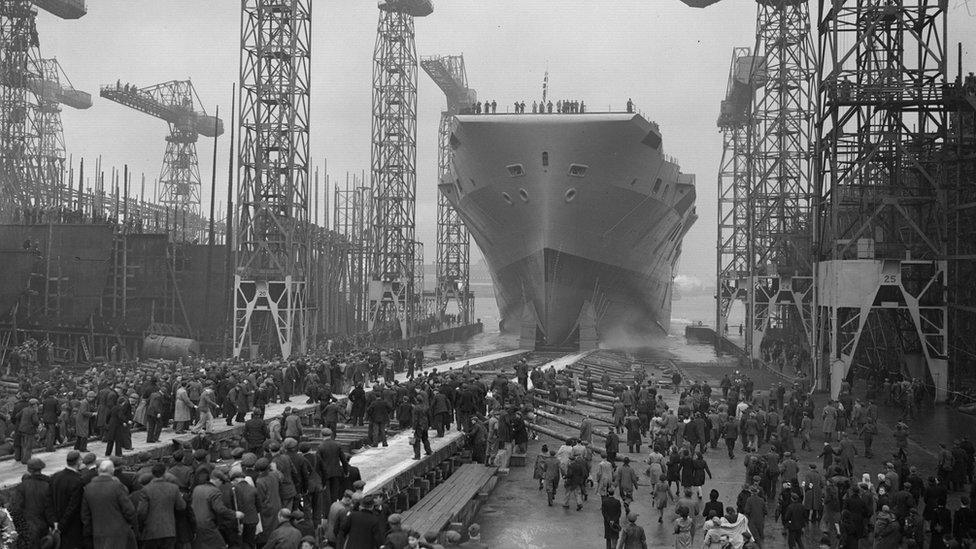Harland and Wolff: Administrators appointed to shipyard firm
- Published
- comments

Accountancy firm BDO has been appointed administrators to Harland and Wolff, a spokesman for the Belfast shipyard has said.
An insolvency request is expected to be filed at the High Court in Belfast on Tuesday.
The move puts 120 jobs at risk and could spell the end of the iconic firm, best known for building the Titanic.
Union sources said staff were given redundancy notices saying the business will cease trading on Monday evening.
The history of the Belfast shipyard
A week ago, workers said they had taken control of the site and established a rota to ensure their protest continued around the clock.
After the administrators were appointed on Monday, workers said their protest would continue.
At a press conference, trade unionists representing staff warned they will stand against the DUP in a forthcoming general election if the party does not do more to support workers.

Unions representing H&W workers held a press conference on Monday
Harland and Wolff's best known vessel is the Titanic, which was built at the yard between 1909 and 1911.
At its height, Harland and Wolff employed more than 30,000 people.
The firm had been up for sale amid serious financial problems at its Norwegian owner.
Unions representing workers have called for the shipyard to be nationalised, arguing that it would be cheaper for the government to keep the shipyard open.
However, the government has said the crisis is "ultimately a commercial issue".
'No order book'
East Belfast MP Gavin Robinson, from the DUP, said officials had advised against government intervention.
"We've pulled all the political levers that we can," he told the BBC's Good Morning Ulster programme.

DUP MP Gavin Robinson said government intervention would conflict with state aid rules
The MP said Harland and Wolff had asked the government for shortfall funding of £650,000, which would have given the company "breathing space" for the month of August "so that they could explore other options".
But he added: "The official advice is that it cannot be done for three reasons: there is no order book at present so the money would be going in with no generation of product or profit; and there was no ability to secure the loans or pay them back; and it would also conflict with state aid rules."
Shadow Chancellor John McDonnell said Labour would have nationalised the shipyard and he accused the government of betraying the workers.

John McDonnell said Harland and Wolff could win future Navy contracts
Mr McDonnell, who visited Harland and Wolff staff in Belfast on Monday, said the shipyard has the potential for future work.
He said he saw no reason why naval ships could not be built in Belfast in the future, in order to maintain the skills and capacity at Harland and Wolff.
Warships
The Irish Congress of Trade Unions (ICTU) said the shipyard "should be returned to the people".
"The entire trade union movement across these islands stands as one with the workers at the shipyard," said ICTU assistant general secretary, Owen Reidy.

The HMS Eagle was launched by Princess Elizabeth in March 1946
Prolific builder of ocean liners
The shipyard was founded in 1861 by Yorkshireman Edward Harland and a German, Gustav Wolff.
By the early 20th Century, it was the world's most prolific builder of ocean liners.
It was one of Northern Ireland's key industrial assets during World War Two, producing 140 warships, 123 merchant ships and more than 500 tanks.
Its workforce reached a peak in the post-war years when it employed about 35,000 people.
By the late 1950s, the yard was facing increased global competition and the impact of the rise of air travel.

The Canberra was built for P&O to sail between London and Sydney
The launch of the Canberra in 1960 marked the last cruise liner to be built in Belfast.
By the mid-1960s the business was in serious decline.
At one stage in 1966, the management went to the old Stormont government and pleaded for a subsidy because it did not have enough money to cover the next pay day.
That was the start of more than 30 years of subsidies, during which about £1bn of taxpayers' money was pumped into Harland and Wolff to keep it afloat.
The firm was nationalised in 1975 with the Northern Ireland Office minister, Stan Orme, describing the business as having "a sorry financial record".

Much of the shipyard's work in recent years has been in the construction of offshore wind turbines
By that stage it was still employing about 10,000 people.
It returned to private ownership in 1989 through a management-employee buyout, backed by the Norwegian industrialist Fred Olsen.
It increasingly focused on the oil and gas sectors, but struggled to compete against major shipbuilders in east Asia.

The Anvil Point beneath the Harland and Wolff cranes after it was built in 2003
The yard built its last ship in 2003 - a Ministry of Defence ferry called the Anvil Point.
Since then, it has worked on other areas of marine engineering such as oil rig refurbishment and offshore wind turbines.
What happens now?
The administrators will try to restart a sales process.
There is likely to be some interest. The Newry firm, MJM, that specialises in ship fitout, is a potential bidder.
At least one property company is also interested in the business.
But the future is not bright for the workforce, even if the business is sold to a new industrial operator.
- Published5 August 2019

- Published2 August 2019

- Published30 July 2019
